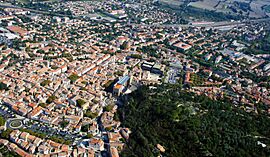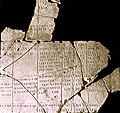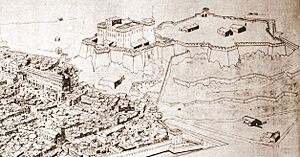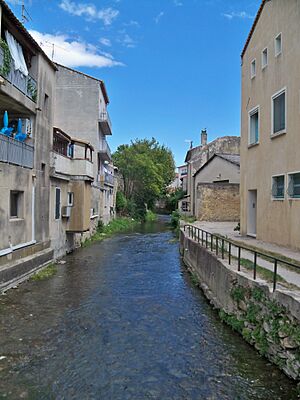Orange, Vaucluse facts for kids
Quick facts for kids
Orange
Aurenja (Occitan)
|
||
|---|---|---|

Aerial view of central Orange
|
||
|
||
| Country | France | |
| Region | Provence-Alpes-Côte d'Azur | |
| Department | Vaucluse | |
| Arrondissement | Carpentras | |
| Canton | Orange | |
| Intercommunality | Pays Réuni d'Orange | |
| Area
1
|
74.2 km2 (28.6 sq mi) | |
| Population
(2021)
|
28,949 | |
| • Density | 390.15/km2 (1,010.5/sq mi) | |
| Time zone | UTC+01:00 (CET) | |
| • Summer (DST) | UTC+02:00 (CEST) | |
| INSEE/Postal code |
84087 /84100
|
|
| Elevation | 24–127 m (79–417 ft) (avg. 50 m or 160 ft) |
|
| 1 French Land Register data, which excludes lakes, ponds, glaciers > 1 km2 (0.386 sq mi or 247 acres) and river estuaries. | ||
| UNESCO World Heritage Site | |
|---|---|
 |
|
| Includes | Roman Theatre of Orange and Triumphal Arch of Orange |
| Criteria | Cultural: iii, vi |
| Inscription | 1981 (5th Session) |
Orange is a city in southeastern France. It is located in the Vaucluse area, which is part of the Provence-Alpes-Côte d'Azur region. Orange is about 21 kilometers (13 miles) north of Avignon.
The city is the second-largest in Vaucluse by population, right after Avignon. Orange is famous for its amazing ancient Roman buildings.
Contents
The Name of Orange
The name Orange has changed over time. In ancient Roman times, it was called Arausio or Arausion. Later, it was known as Aurengia and Orenga.
The original name, Arausio, comes from an old Gaulish word. This word meant 'temple' or 'cheek'. It was related to a very old Celtic word meaning 'in front of the ear'. The name Orange is not related to the fruit, but people later started to connect the two.
History of Orange
Orange has a very long and interesting history. It was first settled by the Celts, an ancient people.
Roman Orange: A City of History
The Roman city of Orange was founded in 35 BC. It was built by soldiers from the second Roman legion. They named it Arausio after a local Celtic water god. The full name was Colonia Julia Firma Secundanorum Arausio. This means "the Julian colony of Arausio established by the soldiers of the second legion."
Before the Roman city, a big battle happened here in 105 BC. It was called the Battle of Arausio. Two Roman armies fought against the Cimbri and Teutones tribes.
The Roman city of Arausio was large, covering about 69 hectares (170 acres). It had many important public buildings. Besides the famous theatre and arch, there was a huge temple complex and a forum. A forum was a public square where people met.
Orange was like a smaller version of Rome itself. It had many of the same buildings that Romans would know. These buildings were just made smaller to fit the city's population. You can see Orange on old Roman maps like the Tabula Peutingeriana.
-
Roman cadaster of Orange
From Visigoths to the Principality
The city grew and did well for a long time. But in 412, it was attacked by the Visigoths, a Germanic tribe. By this time, many people in Orange had become Christian. From the late 200s, Orange became a center for the Christian church.
Important church meetings, called synods, were held in Orange. One famous meeting in 529 helped define Christian beliefs.
Later, in the 700s, counts ruled Orange. These counts were part of the Carolingian dynasty. In the 1100s, Orange became a small principality. This meant it was a small state ruled by a prince. It was part of the Holy Roman Empire.
The House of Orange-Nassau
In 1544, William the Silent became the Prince of Orange. He was also a count in the Netherlands. This connected the small principality of Orange to the powerful House of Orange-Nassau. This family became very important in the Netherlands.
Because of this connection, Orange became involved in the French Wars of Religion. The city was badly damaged during these wars. In 1568, the Eighty Years' War began. William the Silent led the Dutch fight for independence from Spain.
William the Silent was killed in 1584. His son, Maurice of Nassau, continued the fight. He helped the Dutch Republic become independent. Today, the Netherlands is still ruled by the House of Orange-Nassau.
The name Orange also spread to other parts of the world. Places like the Oranges in New Jersey, USA, and the Orange Free State in South Africa got their names from this family.
Orange Becomes Part of France
The city of Orange was captured many times by the forces of Louis XIV, the King of France. This happened during his wars in the late 1600s. Orange was finally given to France in 1713. This was part of the Treaty of Utrecht.
After the French Revolution in 1789, Orange became part of different French departments. It finally became part of the Vaucluse department. Even though the city became French, the title "Prince of Orange" stayed with the Dutch royal family.
Recent History
In 1995, Orange gained international attention. The city elected Jacques Bompard as its mayor. He was a member of the National Front party at the time. Later, he left that party and started his own, the League of the South.
Orange was also home to the French Foreign Legion's First Foreign Cavalry Regiment. This military unit moved to a new location in 2014.
Population of Orange
Orange is the second-largest city in Vaucluse by population. As of 2018, about 28,922 people live there. It is just smaller than Avignon and larger than Carpentras.
| Historical population | |||||||||||||||||||||||||||||||||||||||||||||||||||||||||||||||||||||||||||||||||||||||||||||||||||||||||||||||||||
|---|---|---|---|---|---|---|---|---|---|---|---|---|---|---|---|---|---|---|---|---|---|---|---|---|---|---|---|---|---|---|---|---|---|---|---|---|---|---|---|---|---|---|---|---|---|---|---|---|---|---|---|---|---|---|---|---|---|---|---|---|---|---|---|---|---|---|---|---|---|---|---|---|---|---|---|---|---|---|---|---|---|---|---|---|---|---|---|---|---|---|---|---|---|---|---|---|---|---|---|---|---|---|---|---|---|---|---|---|---|---|---|---|---|---|---|
|
|
||||||||||||||||||||||||||||||||||||||||||||||||||||||||||||||||||||||||||||||||||||||||||||||||||||||||||||||||||
| Source: EHESS and INSEE (1968-2020) | |||||||||||||||||||||||||||||||||||||||||||||||||||||||||||||||||||||||||||||||||||||||||||||||||||||||||||||||||||
Main Sights in Orange
Orange is famous for its amazing Roman buildings. These ancient structures show how important the city was in Roman times.
The Roman Theatre and Triumphal Arch
The Roman theatre is one of the most impressive ancient theatres still standing in Europe. It is very well preserved.
The Triumphal Arch is another incredible Roman monument. Experts believe it was built during the time of Emperor Augustus. An inscription on the arch shows it was rebuilt in AD 27. This was to celebrate the victories of a Roman general named Germanicus.
In 1981, UNESCO recognized these two sites. The arch, theatre, and the area around them were listed as a World Heritage Site. This means they are very important to human history and should be protected.
The Museum of Orange
The city's museum has a unique treasure. It displays the largest Roman maps ever found. These maps are etched onto marble. They show the area between Orange, Nîmes, and Montélimar.
Culture in Orange
Orange is not just about ancient history; it also has a lively culture.
Chorégies d'Orange: A Music Festival
The Roman theatre was restored in 1869. Since then, it has been used for a music festival. In 1902, this festival was named Chorégies d'Orange.
It has been held every year since then. Today, it is a famous international opera festival. Many top opera singers from around the world have performed there. These include Plácido Domingo and Montserrat Caballé. Famous operas like Tosca and Aida have been staged in the theatre.
The Roman theatre is one of the few places where parts of the original Roman wall still stand.
Transportation
Orange has good train connections. The SNCF offers train service north to Lyon and Paris. You can also travel south to Avignon and Marseille by train.
Twin Towns and Sister Cities
Orange has special connections with other cities around the world. These are called twin towns or sister cities. They share culture and friendship.
- Breda, Netherlands (since 1963)
- Byblos, Lebanon (since 2004)
- Diest, Belgium (since 1963)
- Dillenburg, Germany (since 1963)
- Jarosław, Poland (since 2000)
- Kielce, Poland (since 1992)
- Rastatt, Germany (since 1965)
- Spoleto, Italy (since 1981)
- Vélez-Rubio, Spain (since 2004)
- Weifang, China (since 2004)
Orange also forms a group called the Union of Orange Cities. This group includes Breda, Diest, and Dillenburg.
Climate
Orange has a humid subtropical climate. This means it has hot and fairly dry summers. Most of the rain falls in spring and autumn. Winters are mild, but it can sometimes get very cold or snow.
On June 28, 2019, the temperature in Orange reached 41.0 °C (105.8 °F).
| Climate data for Orange, France (altitude 53m, 1981–2010 averages, extremes 1952–present) | |||||||||||||
|---|---|---|---|---|---|---|---|---|---|---|---|---|---|
| Month | Jan | Feb | Mar | Apr | May | Jun | Jul | Aug | Sep | Oct | Nov | Dec | Year |
| Record high °C (°F) | 20.5 (68.9) |
23.0 (73.4) |
27.2 (81.0) |
31.2 (88.2) |
34.5 (94.1) |
41.0 (105.8) |
40.7 (105.3) |
42.6 (108.7) |
35.8 (96.4) |
30.9 (87.6) |
24.6 (76.3) |
20.2 (68.4) |
42.6 (108.7) |
| Mean daily maximum °C (°F) | 9.9 (49.8) |
11.7 (53.1) |
15.6 (60.1) |
18.6 (65.5) |
23.2 (73.8) |
27.4 (81.3) |
30.8 (87.4) |
30.2 (86.4) |
25.2 (77.4) |
20.0 (68.0) |
13.7 (56.7) |
10.1 (50.2) |
19.7 (67.5) |
| Daily mean °C (°F) | 5.8 (42.4) |
7.0 (44.6) |
10.4 (50.7) |
13.2 (55.8) |
17.5 (63.5) |
21.4 (70.5) |
24.4 (75.9) |
23.9 (75.0) |
19.7 (67.5) |
15.3 (59.5) |
9.7 (49.5) |
6.4 (43.5) |
14.6 (58.3) |
| Mean daily minimum °C (°F) | 1.6 (34.9) |
2.4 (36.3) |
5.2 (41.4) |
7.8 (46.0) |
11.8 (53.2) |
15.4 (59.7) |
18.0 (64.4) |
17.6 (63.7) |
14.1 (57.4) |
10.6 (51.1) |
5.7 (42.3) |
2.7 (36.9) |
9.4 (48.9) |
| Record low °C (°F) | −13.4 (7.9) |
−14.5 (5.9) |
−9.7 (14.5) |
−2.9 (26.8) |
1.3 (34.3) |
5.7 (42.3) |
9.5 (49.1) |
8.3 (46.9) |
3.1 (37.6) |
−1.6 (29.1) |
−5.8 (21.6) |
−14.4 (6.1) |
−14.5 (5.9) |
| Average precipitation mm (inches) | 51.0 (2.01) |
39.4 (1.55) |
43.9 (1.73) |
66.0 (2.60) |
65.3 (2.57) |
38.3 (1.51) |
36.9 (1.45) |
42.3 (1.67) |
102.0 (4.02) |
92.9 (3.66) |
75.4 (2.97) |
55.7 (2.19) |
709.1 (27.92) |
| Average precipitation days (≥ 1.0 mm) | 5.7 | 4.9 | 4.9 | 7.2 | 6.3 | 4.7 | 3.0 | 3.5 | 5.5 | 7.2 | 6.6 | 6.4 | 66.0 |
| Average relative humidity (%) | 77 | 74 | 69 | 66 | 66 | 64 | 71 | 78 | 78 | 79 | 71 | 77 | 72.5 |
| Mean monthly sunshine hours | 132.0 | 137.1 | 192.5 | 230.4 | 264.6 | 298.9 | 345.3 | 310.7 | 237.6 | 187.1 | 135.2 | 123.8 | 2,595.2 |
| Source 1: Météo France | |||||||||||||
| Source 2: Infoclimat.fr (humidity 1961–1990) | |||||||||||||
See also
 In Spanish: Orange (Vaucluse) para niños
In Spanish: Orange (Vaucluse) para niños










